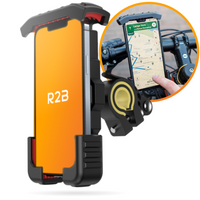No Products in the Cart

Always On the Go? This is how Laptop Charging with Powerbank works!
Time to read 4 min
Time to read 4 min
A power bank can be your savior when your laptop battery is empty and there is no socket in sight. But how do you choose the right one? Read on for essential tips on charging your laptop with a power bank, choosing between USB-C and standard connections, and how to do it safely, whether you're at home or on the road. In this article, we will discuss how to charge your laptop with power bank efficiently and safely.
Most important points
Choose a power bank with a capacity that matches the input requirements of your laptop and a minimum capacity of 20,000 mAh due to energy loss during charging.
USB-C PD power banks are more suitable for faster charging of laptops than standard USB power banks due to their power up to 100W and matching the voltage to the connected device.
For safe charging on the go, make sure the power bank's output voltage matches your laptop and use quality cables and devices from reputable manufacturers.
When choosing a power bank laptop, there are some important factors to consider. One of them is the power of the power bank. This should match the input requirements of your laptop. For example, a Mobisun laptop power bank can supply up to 94 Watts, which is sufficient for various laptops and MacBooks.
Another important aspect is the sufficient capacity of the power bank, expressed in mAh. It is recommended to choose a power bank with a capacity of at least 20,000 mAh for laptops, as approximately 2/3rds of the stated capacity is actually usable due to energy loss.
To determine how often a power bank can charge your laptop, you must compare the power of the power bank with the power of your laptop. Sometimes you need to convert the capacity from Watt hours (Wh) to mAh.
It is also crucial to check the output voltage of the power bank. Too high a voltage can damage your laptop, so make sure it matches the input voltage of your laptop charger.
There are different types of power banks on the market, but the two most common types are USB-C PD (Power Delivery) and standard USB. But what is the difference between these two?
Power banks with a USB-C PD connection can charge devices such as laptops faster than standard USB connections. This is because USB-C PD can deliver up to 100W of power, while standard USB connections deliver significantly less power.
Additionally, USB-C PD on power banks can accurately match the voltage to the connected device via the USB port, ensuring more efficient and safer charging. This is especially useful for mobile devices that support fast charging, such as iPhones from the iPhone 8 and new Android smartphones.
Finally, the USB-C connector is reversible, meaning the cables are never connected the wrong way around. This is an advantage that does not apply to standard USB connections.
If you're wondering how much mAh your laptop needs, there are a few factors to consider. First, you need to know the capacity of your laptop battery. In addition, you must take into account energy loss during charging.
The required capacity for a power bank may vary depending on the type of laptop. Ultrabooks often require less capacity than gaming laptops. For ultrabooks, a capacity of 20,000 mAh is usually sufficient, while larger laptops such as the Macbook Pro may require a power bank with 27,000 mAh.
Additionally, your choice of power bank capacity is also influenced by how often you want to be able to charge your laptop without access to a wall socket and the charging time, which depends on the capacity of both the power bank and the laptop battery, and the energy the laptop uses. used during charging.
Charging your laptop with a power bank is very useful, especially if you are on the road and want to be able to use your laptop everywhere. But it is also important to protect your laptop while charging with a power bank. Always choose a good-quality power bank to minimize energy loss and other risks.
Also make sure that the output voltage of the power bank matches the input voltage of your laptop charger to avoid damage. Use the correct cables to connect the laptop to the power bank. For example, if your laptop has a USB-C port, use a USB-C to USB-C cable. It is also important to use devices, batteries and chargers from reputable manufacturers to reduce the risk of overheating.
Finally, always stay alert while charging and check for signs of overheating such as a strong odor, smoke or leaking fluid.
There are many different types of power banks on the market, but if you're looking for the most laptop power banks with compact options, the R2B Power Bank 20,000 mAh and the Baseus PPBLD100-X are excellent choices. These power banks are not only small enough to carry in a bag or pocket, but they also offer high capacity and powerful output for efficient laptop charging.
Other compact power banks include the Anker 747 PowerCore 26K and the Omnicharge Omni Mobile 25600. These power banks offer extensive charging options with USB-C PD and multiple ports, while the Omnicharge Omni 20c+ and Einova Eggtronic add extra features such as wireless charging and hub functionality.
In this blog post, we discussed how to choose the right power bank for your laptop, the differences between USB-C PD and standard USB power banks , how many mAh your laptop needs, and how to safely charge your laptop with a power bank. We hope this information helps you make the best choice. Remember, with the right power bank you can charge your laptop anywhere, anytime!

